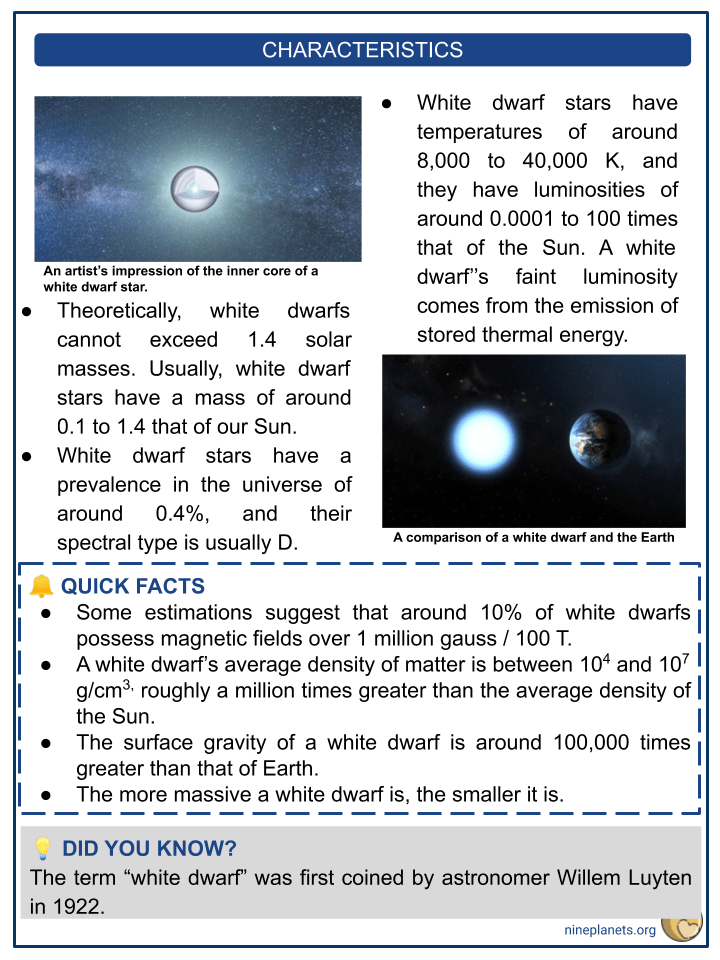Download White Dwarf Star Worksheet
Click the button below to get instant access to these premium worksheets for use in the classroom or at a home.

This worksheet can be edited by Premium members using the free Google Slides online software. Click the Edit button above to get started.
Download free sample
Not ready to purchase a subscription yet? Click here to download a FREE sample of this worksheet pack.
Resource Examples
Click any of the example images below to view a larger version.




Key Facts & Information
- A white dwarf star, also called a degenerate dwarf, is a stellar core remnant composed mostly out of electron-degenerate matter. A white dwarf is quite dense, its mass may be comparable to that of the Sun, while its volume could be comparable to that of Earth.
- It is theorised that white dwarfs represent the endpoint of stellar evolution for main-sequence stars with masses from about 0.07 to 10 solar masses.
- The composition of the white dwarf will depend on the initial mass of the star. The central region of a white dwarf star is a thin envelope of helium and usually an even thinner layer of hydrogen.
- Few white dwarfs are surrounded by a thin carbon envelope. Only the outermost stellar layers are accessible to astronomical observations.
Formation
- White dwarfs evolve from stars with an initial mass of up to three or four solar masses, possibly even higher.
- White dwarfs form when the hot planetary nebula created by a red giant star loses its envelope, which was several times expanded by its red giant phase. When the hot planetary nebula cools down, the star becomes a white dwarf.
Characteristics
- White dwarf stars have temperatures of around 8,000 to 40,000 K, and they have luminosities of around 0.0001 to 100 times that of the Sun. A white dwarf’’s faint luminosity comes from the emission of stored thermal energy.
- Theoretically, white dwarfs cannot exceed 1.4 solar masses. Usually, white dwarf stars have a mass of around 0.1 to 1.4 that of our Sun.
- White dwarf stars have a prevalence in the universe of around 0.4%, and their spectral type is usually D.
Quick Facts
- Some estimations suggest that around 10% of white dwarfs possess magnetic fields over 1 million gauss / 100 T.
- A white dwarf’s average density of matter is between 104 and 107 g/cm3, roughly a million times greater than the average density of the Sun.
- The surface gravity of a white dwarf is around 100,000 times greater than that of Earth.
- The more massive a white dwarf is, the smaller it is.
Did You Know?
- The term “white dwarf” was first coined by astronomer Willem Luyten in 1922.
Radiation And Cooling
- White dwarfs have exhausted their nuclear fuel and have no residual nuclear energy source. They’re very compact, and because of this, there is no further gravitational contraction.
- The energy radiated away into the interstellar medium is provided by the residual thermal energy of the nondegenerate ions inside a white dwarf’s core. This energy slowly diffuses outward the insulating stellar envelope, and the white dwarf slowly cools down.
- Once a complete exhaustion of this thermal energy occurs, white dwarf stops radiating and has by then reached the final stage of its evolution and becomes a cold and inert stellar remnant.
- The degenerate matter that makes up the bulk of a white dwarf has a low opacity yet a high thermal conductivity. As a result, the interior of a white dwarf maintains a uniform temperature, about 107 K.
- A white dwarf remains visible for a long period of time, as its tenuous atmosphere of normal matter begins to radiate at 107 K, upon formation, while its greater interior mass is at 107 K yet cannot radiate through its normal matter shell.
Observation Of White Dwarfs
- White dwarfs are somewhat difficult to observe due to their dimness.
- Some of the observed white dwarfs were so faint that the brightest of them was no more luminous than a 100 watt light bulb seen at the Moon’s distance.
- The first white dwarf discovered was found since its companion star, Sirius, is among the brightest.
- White dwarfs are also very small and thus hard to detect. They are usually found if they are part of a binary system.
- The Hubble Space Telescope has observed more than 75 white dwarfs since it was launched.
- Since age is a huge factor when it comes white dwarf populations, they should theoretically be prevalent in old globular clusters, such as the M4 globular cluster in the constellation of Scorpius.
Examples Of White Dwarfs
- White dwarf stars are typically found in binary systems, as is the case for the white dwarf companion, Sirius B, which accompanies Sirius A, the brightest star in the night sky.
- Sirius B is one of the most massive white dwarfs so far discovered; its mass is the same as that of the Sun approximately.
- Like all white dwarfs, it is small, having a radius of only 0.008 times that of the Sun, which makes it smaller than the Earth. Though the white dwarf is tinier than our planet, it is quite dense. One cubic inch of its material would weigh 13.6 metric tons (15 tons) on Earth.
- Like most seen so far, it is hot, at approximately 25,000 K.
- Sirius B was the second white dwarf to be discovered (1896) next to 40 Eridani.
- It is the nearest known dwarf star at a distance of 8.6 light years away. Followed by Procyon B which is 11 light years away, and Van Maanen, with a distance of 14 light years from the Earth.
- The first white dwarf that was discovered by Bessel in 1844 was in the triple star system of 40 Eridani. This star system contains a main-sequence star, a white dwarf and a red dwarf star.
- Procyon B is considerably less massive than Sirius B; however, the peculiarities of degenerate matter ensure that it is larger than its more famous neighbour, with an estimated radius of 8,600 km, versus 5,800 km for Sirius B.
- For reasons that remain unclear, the mass of Procyon B is unusually low for a white dwarf star of its type. With a surface temperature of 7,740 K, it is also much cooler than Sirius B which confirms its lesser mass and greater age.
- The name Procyon comes from a Greek word meaning “before the dog”, since it precedes the “Dog Star” Sirius as it travels across the sky due to Earth’s rotation.
- Van Maanen is the closest known solitary white dwarf to the Solar System. It is a dense, compact stellar remnant no longer generating energy and has equivalent to about 68% of the Sun’s mass but only 1% of its radius.
- Discovered in 1917, Van Maanen was the third white dwarf identified, after 40 Eridani B and Sirius B, and the first solitary example.
- Another example of a white dwarf is the one situated in the centre of the Helix Nebula. The white dwarf there continues to emit large amounts of ultraviolet radiation, which heats up the gases in the nebula and gives it its characteristic colours.
- It is theorised that there are around eight white dwarfs among the hundred star systems nearest to the Sun.
Future
- A white dwarf, once formed, will remain stable and will continue to cool almost indefinitely, eventually becoming a black dwarf.
- If the universe continues to expand, it is thought that in 1019 to 1020 years, the galaxies will evaporate as their stars escape into intergalactic space.
- White dwarfs should survive galactic dispersion. However, an occasional collision between these stars that are relative close in proximity may produce a new fusing star of a super- Chandrasekhar mass white dwarf triggering a chain reaction that will explode in a type la supernova.
- White dwarfs can also be cannibalised or evaporated by a companion star, thus causing the white dwarf to lose much of its mass, becoming a planetary object, a host star, maybe even a helium or diamond planet.
- It is theorised that our Sun will become a red giant, after which it will morph into a white dwarf star.